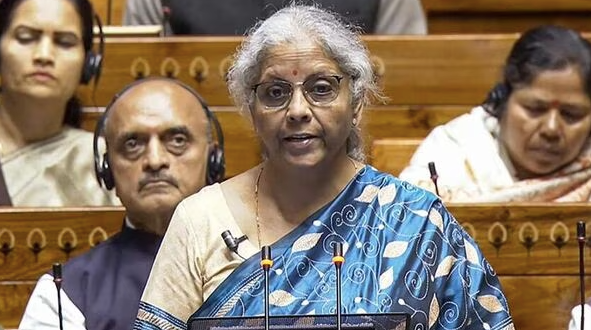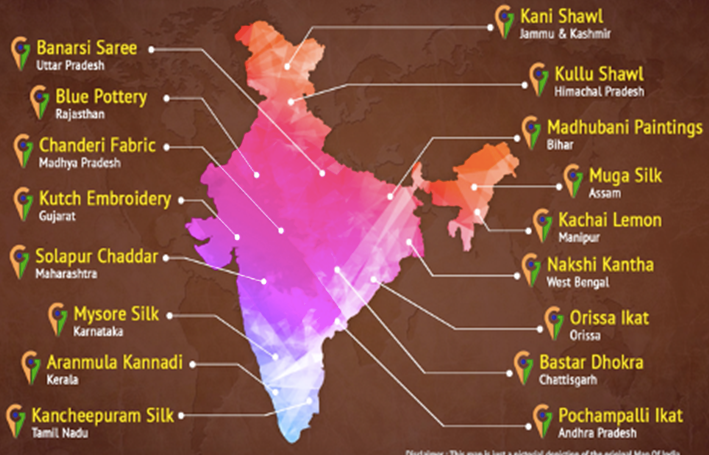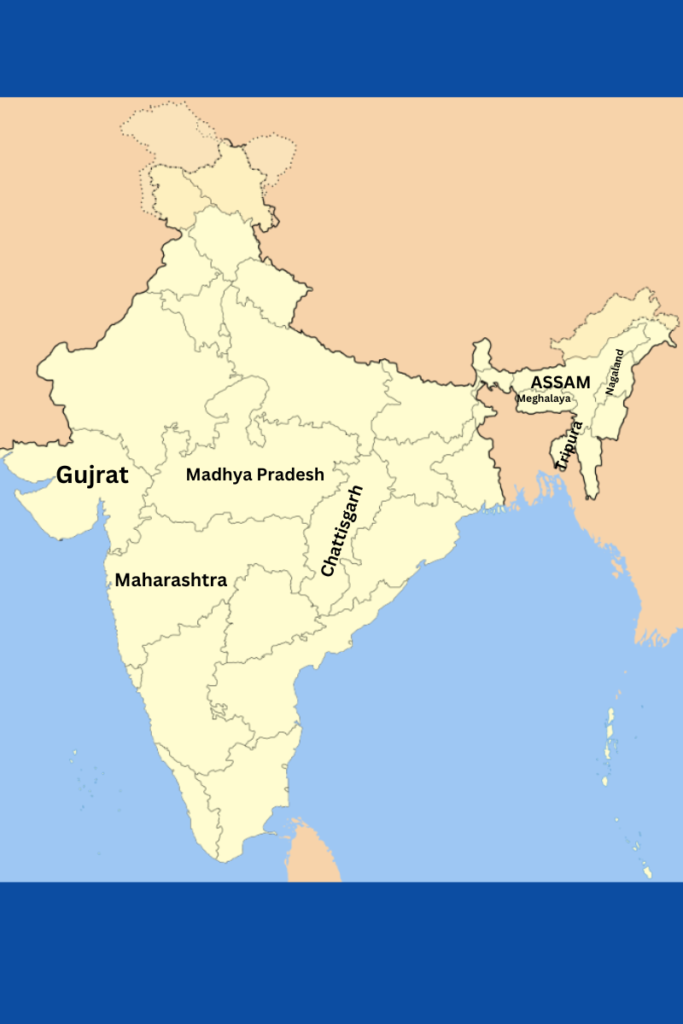
( Source – Print Wikipedia Page)
The Union government plans to build malls called “Unity Malls “ in each state of the country.
These Malls will be in important locations like state capitals, financial centres, or tourist spots. They will have a unique design which demonstrates India’s unity and will include features for example standardized signs and logos representing India’s diversity.
Mall Design, Amenities and features:
The Department of Expenditure in the Ministry of Finance ,Government of India has issued comprehensive guidelines to states regarding the construction of Unity Malls:
For example the architecture design of these malls should signify India’s unity and Grandeur.They are required to have a standardize signage design, as prescribed by Department for and promotion of industry and internal trade (DPIIT).It should be incorporated logos example ODOP and Make in India.Multilingual signage will highlight india’s linguistic diversity.
The guideline specifies that each Unity Mall should have a minimum 36 commercial spaces, and among these, one space should be designated for each state or Union territory ( UT ) for the sale and promotion of ODOP ( one District one product ) products.This designated spaces will provide a platform for showcasing and selling products that are unique to each state or UT, so it will promote the diversity of indian cultural and economic heritage.
These spaces will have uniform floor space, that means they will be equal size, and they will be subject to consistent rental provisions to ensure fairness among all states and UTs.
Additionally, these designated spaces will enable the sale of geographical indication (GI) products, ODOP offerings, and other prominent regional products. This not only supports local artisans and entrepreneurs but also allows visitors to the Unity Mall to explore and purchase a wide variety of unique and authentic products from different parts of the country.For example

The design of Unity Malls should be in such a way that allows for the possibility of increasing the number of commercial spaces in the future if the need arises. This flexibility in design means that the layout and structure of the malls should be adaptable and adjustable. For example, the architecture and construction should allow for easy expansion by adding new sections of floors or by modifying existing areas to create more commercial spaces without having to destruct the entire building. This approach ensures that the Unity Malls can grow and evolve along with the changing demands and requirements of the market and community they serve.
The Unity Malls project aims to create lively and welcoming spaces that meet the needs of all kinds of people. Each mall will have modern facilities for example good places to eat, good parking, and areas for fun activities and cultural events. They will also have rooms for meetings, art shows, and exhibitions. Additionally, they will offer tech stuff such as virtual reality and interactive screens to make the experience more exciting. Making sure everyone can easily get around and use the facilities is really important. And the government wants to help small businesses from faraway places be part of the malls too, which is great for everyone. These malls will be like lively meeting spots where people can enjoy India’s diverse culture and help local businesses grow.
It’s important to make sure that Unity Malls are easy to use and accessible for everyone, following the rules set out in the National Building Code. This means making sure there are things like ramps for people who use wheelchairs, clear signs, and easy-to-navigate paths. Also, the government is asking states to help out by giving financial support to sellers who come from faraway places and remote areas. This support will make it easier for these sellers to take part in the malls and share their products with everyone. therefore, by focusing on accessibility and giving a helping hand to sellers from distant areas, the Unity Malls can become welcoming places where everyone can enjoy and explore.
States are being told to promote Unity Malls as exciting places full of culture and great for tourists to visit. And to make sure these malls last a long time, they’ll be run and looked after by both the government and private companies working together. That is the ppp model.The government will own the malls, but the private companies will take care of running them and keeping them in good shape. This way, Unity Malls can stay open and enjoyable for everyone to visit for years to come.
The government has suggested that the partnership between the state and private companies for running Unity Malls should last for a period of 30 years. During these 30 years, the private companies will manage the day-to-day operations and maintenance of the malls, while the government will still own them. This means that for three decades, the private companies will be responsible for ensuring that the malls are well-kept and running smoothly, while the government will oversee things from a distance. This arrangement allows both parties to work together effectively to ensure the success and sustainability of the Unity Malls over the long term.
States should be ready to pay for the day-to-day costs of running the malls if needed. If a state or district decides not to be part of the mall, the private companies in charge of running the malls will find other sellers to showcase and sell products specific to that area. Also, artisans who cannot get a spot in the mall will still get chances to display and sell their products at special exhibition spaces from time to time. So, even if a state doesn’t join in or if artisans can’t get a spot in the mall, there are still ways for them to be involved and sell their goods.
To get approval for building Unity Malls, a Detailed Project Report (DPR) is sent to the Department for Promotion of Industry and Internal Trade (DPIIT). They carefully check it and then suggest an amount of money to the Department of Expenditure, which gives the final approval and provides the funds. Currently, approval has been given for building Unity Malls in eight states: Assam, Chhattisgarh, Gujarat, Madhya Pradesh, Maharashtra, Meghalaya, Nagaland, and Tripura. The central government is helping out by setting aside a big amount of money, Rs 5,000 crore, through a special scheme. This money will be given to states as a loan without any interest for 50 years to support the construction of Unity Malls. States will also chip in by giving land for the malls for free and might even give extra money from their own budgets. The idea to build Unity Malls across the country came from the success of the ‘Ekta Mall’ in Kevadia, Gujarat.

Advantages:
- Infrastructure Development: Building Unity Malls will improve infrastructure across the country, making things like roads and buildings better.
- Economic Prosperity: It will help the ‘Make in India’ and ‘Self-reliant India’ initiatives by boosting investment in local businesses.
- Opportunities for Artisans: Local artisans will get a chance to display and sell their goods, which will create more jobs and help them learn new skills.
- Boost Tourism: The malls will attract more tourists, which is good for local businesses and the economy.
- National Unity and Diversity: Unity Malls will promote unity by celebrating local cuisines and cultural traditions from different parts of the country.
Important Points you should remember for exam for both prelims as well as mains:
Main Examination:
1 . Discuss the role of Unity Malls in promoting economic development and cultural diversity in India.
2. Analyze the impact of the Rs 5,000 crore investment in Unity Malls on the infrastructure and tourism sectors of the country.
3.Evaluate the effectiveness of the Ministry of Finance in overseeing the implementation of Unity Malls across different states.
4.Assess the significance of the Unity Malls initiative in supporting local artisans and promoting indigenous products.
5.Compare the Unity Malls initiative with similar projects in other countries aimed at boosting economic growth and cultural exchange.
6.Discuss the challenges faced by states in implementing Unity Malls and propose strategies for overcoming them.
7.Evaluate the contribution of Unity Malls to the ‘Make in India’ and ‘Atmanirbhar Bharat’ initiatives in fostering self-reliance and indigenous production.
8.Examine the role of public-private partnerships in ensuring the sustainability and efficient operation of Unity Malls.
9.Analyze the impact of Unity Malls on employment generation and skill development in local communities.
10.Discuss the potential long-term benefits of the Unity Malls initiative in terms of promoting national unity, economic prosperity, and tourism growth.
Prelims
- Ministry responsible: Ministry of Finance, Government of India.
- Fund invested: Rs 5,000 crore.
- States where the Unity Mall initiative is already implemented: Assam, Chhattisgarh, Gujarat, Madhya Pradesh, Maharashtra, Meghalaya, Nagaland, and Tripura.
- PPP model: Used for the operation and maintenance of Unity Malls.
- Concession period: Recommended for PPP model is 30 years.
- Support from Centre: Financial assistance provided through a special scheme for capital expenditure.
- Criteria for commercial spaces: Each Unity Mall should have a minimum of 36 commercial spaces.
- Fund allocation: Based on the number of districts in each state.
- Inspiration: Drawn from the success of ‘Ekta Mall’ in Kevadia, Gujarat.
- Objective: To foster economic development, promote local artisans, boost tourism, and celebrate cultural diversity.
“Unity Malls: Driving Economic Development and Cultural Celebration”
It highlights the significant impact of the Unity Malls initiative on various aspects of Indian society. By fostering economic development, the initiative generates employment opportunities, supports local businesses, and stimulates investment within the country. Additionally, the provision of recreational spaces within the country. Additionally, providing recreational spaces within the malls offers citizens leisure and social interaction, contributing to overall well-being. Furthermore, the promotion of Unity Malls as tourist destinations not only attracts visitors but also showcases India’s diverse cultural heritage, thereby enhancing cultural exchange and understanding. Ultimately, Unity Malls emerge as pivotal hubs that not only boost economic growth but also serve as platforms for celebrating India’s rich cultural tapestry distinctively and inclusively.
This article is taken from the Budget 2023 -24 and decoded in simple language so that it would be easy for you to understand the article effectively.